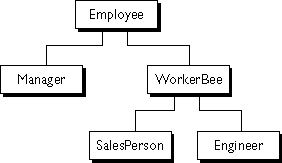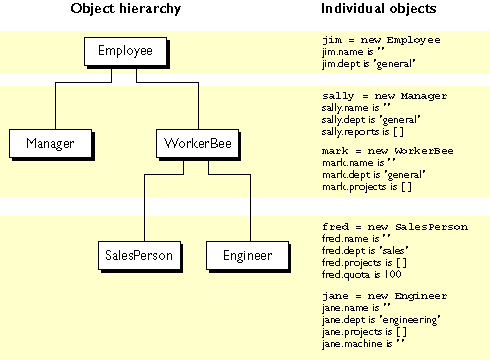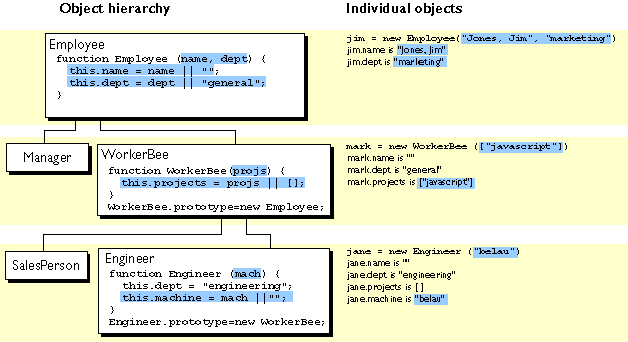
Employee class could represent the set of all employees.Victoria could be an instance of the Employee class, representing a particular individual as an employee. An instance has exactly the properties of its parent class (no more, no less).new operator in association with the constructor method to create class instances.
JavaScript follows a similar model, but does not have a class definition separate from the constructor. Instead, you define a constructor function to create objects with a particular initial set of properties and values. Any JavaScript function can be used as a constructor. You use the new operator with a constructor function to create a new object.
Employee class includes only the name and dept properties, and Manager is a subclass of Employee that adds the reports property. In this case, an instance of the Manager class would have all three properties: name, dept, and reports.
JavaScript implements inheritance by allowing you to associate a prototypical object with any constructor function. So, you can create exactly the Employee-Manager example, but you use slightly different terminology. First you define the Employee constructor function, specifying the name and dept properties. Next, you define the Manager constructor function, specifying the reports property. Finally, you assign a new Employee object as the prototype for the Manager constructor function. Then, when you create a new Manager, it inherits the name and dept properties from the Employee object.
Table 8.1 Comparison of class-based (Java) and prototype-based (JavaScript) object systems
Figure 8.1 A simple object hierarchy

Employee has the properties name (whose value defaults to the empty string) and dept (whose value defaults to "general").Manager is based on Employee. It adds the reports property (whose value defaults to an empty array, intended to have an array of Employee objects as its value).WorkerBee is also based on Employee. It adds the projects property (whose value defaults to an empty array, intended to have an array of strings as its value).SalesPerson is based on WorkerBee. It adds the quota property (whose value defaults to 100). It also overrides the dept property with the value "sales", indicating that all salespersons are in the same department.Engineer is based on WorkerBee. It adds the machine property (whose value defaults to the empty string) and also overrides the dept property with the value "engineering".
Figure 8.2 The Employee object definitions

Employee definitions are similar. The only differences are that you need to specify the type for each property in Java but not in JavaScript, and you need to create an explicit constructor method for the Java class.
Manager and WorkerBee definitions show the difference in how to specify the next object higher in the inheritance chain. In JavaScript, you add a prototypical instance as the value of the prototype property of the constructor function. You can do so at any time after you define the constructor. In Java, you specify the superclass within the class definition. You cannot change the superclass outside the class definition.
Engineer and SalesPerson definitions create objects that descend from WorkerBee and hence from Employee. An object of these types has properties of all the objects above it in the chain. In addition, these definitions override the inherited value of the dept property with new values specific to these objects.
NOTE: The term instance has a specific technical meaning in class-based languages. In these languages, an instance is an individual member of a class and is fundamentally different from a class. In JavaScript, "instance" does not have this technical meaning because JavaScript does not have this difference between classes and instances. However, in talking about JavaScript, "instance" can be used informally to mean an object created using a particular constructor function. So, in this example, you could informally say thatjaneis an instance ofEngineer. Similarly, although the terms parent, child, ancestor, and descendant do not have formal meanings in JavaScript; you can use them informally to refer to objects higher or lower in the prototype chain.
Figure 8.3 Creating objects with simple definitions

mark object as a WorkerBee as shown in Figure 8.3 with the following statement:
mark = new WorkerBee;When JavaScript sees the
new operator, it creates a new generic object and passes this new object as the value of the this keyword to the WorkerBee constructor function. The constructor function explicitly sets the value of the projects property. It also sets the value of the internal __proto__ property to the value of WorkerBee.prototype. (That property name has two underscore characters at the front and two at the end.) The __proto__ property determines the prototype chain used to return property values. Once these properties are set, JavaScript returns the new object and the assignment statement sets the variable mark to that object.
This process does not explicitly put values in the mark object (local values) for the properties mark inherits from the prototype chain. When you ask for the value of a property, JavaScript first checks to see if the value exists in that object. If it does, that value is returned. If the value is not there locally, JavaScript checks the prototype chain (using the __proto__ property). If an object in the prototype chain has a value for the property, that value is returned. If no such property is found, JavaScript says the object does not have the property. In this way, the mark object has the following properties and values:
mark.name = "";The
mark.dept = "general";
mark.projects = [];
mark object inherits values for the name and dept properties from the prototypical object in mark.__proto__. It is assigned a local value for the projects property by the WorkerBee constructor. This gives you inheritance of properties and their values in JavaScript. Some subtleties of this process are discussed in "Property Inheritance Revisited" on page 129.
Because these constructors do not let you supply instance-specific values, this information is generic. The property values are the default ones shared by all new objects created from WorkerBee. You can, of course, change the values of any of these properties. So, you could give specific information for mark as follows:
mark.name = "Doe, Mark";
mark.dept = "admin";
mark.projects = ["navigator"];
mark.bonus = 3000;Now, the
mark object has a bonus property, but no other WorkerBee has this property.
If you add a new property to an object that is being used as the prototype for a constructor function, you add that property to all objects that inherit properties from the prototype. For example, you can add a specialty property to all employees with the following statement:
Employee.prototype.specialty = "none";As soon as JavaScript executes this statement, the
mark object also has the specialty property with the value of "none". The following figure shows the effect of adding this property to the Employee prototype and then overriding it for the Engineer prototype.
Figure 8.5 Specifying properties in a constructor, take 1

this.name = name || "";The JavaScript logical OR operator (
||) evaluates its first argument. If that argument converts to true, the operator returns it. Otherwise, the operator returns the value of the second argument. Therefore, this line of code tests to see if name has a useful value for the name property. If it does, it sets this.name to that value. Otherwise, it sets this.name to the empty string. This chapter uses this idiom for brevity; however, it can be puzzling at first glance.
With these definitions, when you create an instance of an object, you can specify values for the locally defined properties. As shown in Figure 8.5, you can use the following statement to create a new Engineer:
jane = new Engineer("belau");
Jane's properties are now:
jane.name == "";Notice that with these definitions, you cannot specify an initial value for an inherited property such as
jane.dept == "general";
jane.projects == [];
jane.machine == "belau"
name. If you want to specify an initial value for inherited properties in JavaScript, you need to add more code to the constructor function.
So far, the constructor function has created a generic object and then specified local properties and values for the new object. You can have the constructor add more properties by directly calling the constructor function for an object higher in the prototype chain. The following figure shows these new definitions.
Figure 8.6 Specifying properties in a constructor, take 2

Engineer constructor:
function Engineer (name, projs, mach) {
this.base = WorkerBee;
this.base(name, "engineering", projs);
this.machine = mach || "";
}
Suppose you create a new Engineer object as follows:
jane = new Engineer("Doe, Jane", ["navigator", "javascript"], "belau");
JavaScript follows these steps:
new operator creates a generic object and sets its __proto__ property to Engineer.prototype.new operator passes the new object to the Engineer constructor as the value of the this keyword.base for that object and assigns the value of the WorkerBee constructor to the base property. This makes the WorkerBee constructor a method of the Engineer object.base method, passing as its arguments two of the arguments passed to the constructor ("Doe, Jane" and ["navigator", "javascript"]) and also the string "engineering". Explicitly using "engineering" in the constructor indicates that all Engineer objects have the same value for the inherited dept property, and this value overrides the value inherited from Employee.base is a method of Engineer, within the call to base, JavaScript binds the this keyword to the object created in Step 1. Thus, the WorkerBee function in turn passes the "Doe, Jane" and ["navigator", "javascript"] arguments to the Employee constructor function. Upon return from the Employee constructor function, the WorkerBee function uses the remaining argument to set the projects property.base method, the Engineer constructor initializes the object's machine property to "belau".jane variable.WorkerBee constructor from inside the Engineer constructor, you have set up inheritance appropriately for Engineer objects. This is not the case. Calling the WorkerBee constructor ensures that an Engineer object starts out with the properties specified in all constructor functions that are called. However, if you later add properties to the Employee or WorkerBee prototypes, those properties are not inherited by the Engineer object. For example, assume you have the following statements:
function Engineer (name, projs, mach) {
this.base = WorkerBee;
this.base(name, "engineering", projs);
this.machine = mach || "";
}
jane = new Engineer("Doe, Jane", ["navigator", "javascript"], "belau");
Employee.prototype.specialty = "none";
The jane object does not inherit the specialty property. You still need to explicitly set up the prototype to ensure dynamic inheritance. Assume instead you have these statements:
function Engineer (name, projs, mach) {
this.base = WorkerBee;
this.base(name, "engineering", projs);
this.machine = mach || "";
}
Engineer.prototype = new WorkerBee;
jane = new Engineer("Doe, Jane", ["navigator", "javascript"], "belau");
Employee.prototype.specialty = "none";
Now the value of the jane object's specialty property is "none".
__proto__ property).function Employee () {
this.name = "";
this.dept = "general";
}function WorkerBee () {
this.projects = [];
}
WorkerBee.prototype = new Employee;
With these definitions, suppose you create amy as an instance of WorkerBee with the following statement:
amy = new WorkerBee;The
amy object has one local property, projects. The values for the name and dept properties are not local to amy and so are gotten from the amy object's __proto__ property. Thus, amy has these property values:
amy.name == "";Now suppose you change the value of the
amy.dept = "general";
amy.projects == [];
name property in the prototype associated with Employee:
Employee.prototype.name = "Unknown"At first glance, you might expect that new value to propagate down to all the instances of
Employee. However, it does not.
When you create any instance of the Employee object, that instance gets a local value for the name property (the empty string). This means that when you set the WorkerBee prototype by creating a new Employee object, WorkerBee.prototype has a local value for the name property. Therefore, when JavaScript looks up the name property of the amy object (an instance of WorkerBee), JavaScript finds the local value for that property in WorkerBee.prototype. It therefore does not look farther up the chain to Employee.prototype.
If you want to change the value of an object property at run time and have the new value be inherited by all descendants of the object, you cannot define the property in the object's constructor function. Instead, you add it to the constructor's associated prototype. For example, assume you change the preceding code to the following:
function Employee () {
this.dept = "general";
}
Employee.prototype.name = "";function WorkerBee () {
this.projects = [];
}
WorkerBee.prototype = new Employee;amy = new WorkerBee;
Employee.prototype.name = "Unknown";In this case, the
name property of amy becomes "Unknown".
As these examples show, if you want to have default values for object properties and you want to be able to change the default values at run time, you should set the properties in the constructor's prototype, not in the constructor function itself.
instanceof operator for this purpose. JavaScript does not provide instanceof, but you can write such a function yourself.
As discussed in "Inheriting Properties" on page 121, when you use the new operator with a constructor function to create a new object, JavaScript sets the __proto__ property of the new object to the value of the prototype property of the constructor function. You can use this to test the prototype chain.
For example, suppose you have the same set of definitions already shown, with the prototypes set appropriately. Create a __proto__ object as follows:
chris = new Engineer("Pigman, Chris", ["jsd"], "fiji");
With this object, the following statements are all true:
chris.__proto__ == Engineer.prototype;Given this, you could write an
chris.__proto__.__proto__ == WorkerBee.prototype;
chris.__proto__.__proto__.__proto__ == Employee.prototype;
chris.__proto__.__proto__.__proto__.__proto__ == Object.prototype;
chris.__proto__.__proto__.__proto__.__proto__.__proto__ == null;
instanceOf function as follows:
function instanceOf(object, constructor) {
while (object != null) {
if (object == constructor.prototype)
return true;
object = object.__proto__;
}
return false;
}
With this definition, the following expressions are all true:
instanceOf (chris, Engineer)But the following expression is false:
instanceOf (chris, WorkerBee)
instanceOf (chris, Employee)
instanceOf (chris, Object)
instanceOf (chris, SalesPerson)
Employee:
var idCounter = 1;
function Employee (name, dept) {
this.name = name || "";
this.dept = dept || "general";
this.id = idCounter++;
}
With this definition, when you create a new Employee, the constructor assigns it the next ID in sequence and then increments the global ID counter. So, if your next statement is the following, victoria.id is 1 and harry.id is 2:
victoria = new Employee("Pigbert, Victoria", "pubs")
harry = new Employee("Tschopik, Harry", "sales")
At first glance that seems fine. However, idCounter gets incremented every time an Employee object is created, for whatever purpose. If you create the entire Employee hierarchy shown in this chapter, the Employee constructor is called every time you set up a prototype. Suppose you have the following code:
var idCounter = 1;
function Employee (name, dept) {
this.name = name || "";
this.dept = dept || "general";
this.id = idCounter++;
}function Manager (name, dept, reports) {...}
Manager.prototype = new Employee;function WorkerBee (name, dept, projs) {...}
WorkerBee.prototype = new Employee;function Engineer (name, projs, mach) {...}
Engineer.prototype = new WorkerBee;function SalesPerson (name, projs, quota) {...}
SalesPerson.prototype = new WorkerBee;mac = new Engineer("Wood, Mac");
Further assume that the definitions omitted here have the base property and call the constructor above them in the prototype chain. In this case, by the time the mac object is created, mac.id is 5.
Depending on the application, it may or may not matter that the counter has been incremented these extra times. If you care about the exact value of this counter, one possible solution involves instead using the following constructor:
function Employee (name, dept) {
this.name = name || "";
this.dept = dept || "general";
if (name)
this.id = idCounter++;
}
When you create an instance of Employee to use as a prototype, you do not supply arguments to the constructor. Using this definition of the constructor, when you do not supply arguments, the constructor does not assign a value to the id and does not update the counter. Therefore, for an Employee to get an assigned id, you must specify a name for the employee. In this example, mac.id would be 1.
function Hobbyist (hobby) {
this.hobby = hobby || "scuba";
}function Engineer (name, projs, mach, hobby) {
this.base1 = WorkerBee;
this.base1(name, "engineering", projs);
this.base2 = Hobbyist;
this.base2(hobby);
this.machine = mach || "";
}
Engineer.prototype = new WorkerBee;dennis = new Engineer("Doe, Dennis", ["collabra"], "hugo")
Further assume that the definition of WorkerBee is as used earlier in this chapter. In this case, the dennis object has these properties:
dennis.name == "Doe, Dennis"So
dennis.dept == "engineering"
dennis.projects == ["collabra"]
dennis.machine == "hugo"
dennis.hobby == "scuba"
dennis does get the hobby property from the Hobbyist constructor. However, assume you then add a property to the Hobbyist constructor's prototype:
Hobbyist.prototype.equipment = ["mask", "fins", "regulator", "bcd"]The
dennis object does not inherit this new property.
Last Updated: 10/29/98 15:51:11